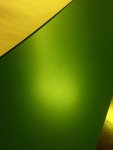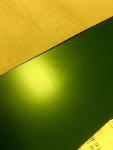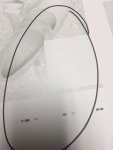doc_hoovie
Member
Hi all, we are running Kodak Thermal Gold plates (600x889x30mm) for one of our presses, and using an older Quartz processor. For weeks on end we have been dealing with scratches that's been resulting in much time and sigs wasted on press to clean them up, or outright makeovers and all the time/cost associated with that. We've tried two different lot numbers, although the time/date stamps between the two lots is only +/- 60 minutes, so the plates were all made at relatively the same time in the factory. Out of the 4 plate sizes we run here, this is only happening on this plate size for the 1 press we have that runs it. Our plant across town is running the same plate size, same lot that one of ours is, with no scratches reported.
We have imaged these plates in both our Magnus VLF via the MCU and our Trendsetter manually, and plates imaged in both units turn up the same type scratches. So we don't believe it's happening in either of those. And we've ruled out our bender.
We had the plate territory sales manager out yesterday and he said the problem was in the processor and frankly his argument/reasons sounded weak. The processor field tech was also here yesterday, although not at the same time as the sales manager. The processor tech said the sales guy don't know what he's talking about and that the processor's good. He points to rough plate handling. We are a small department, 6 people covering 3 shifts. So not that many people here are making the plates, and at 28 years in the company, I'm the least senior--so we've all been doing this a while and know how to handle plates. We've pushed back to the pressroom, and they say nothing nefarious is going on out there, that they've even pulled plates off the rack and found scratches before they even do anything with them. The scratches seem to ebb and flow in severity, frequency and location--nothing straight inline with anything in our process (or the manufacturing process, so sayeth the sales guy). Most seem to be at an angle, and most seem to be able to clean up on press after they've hit it with their chemistry. We are trying to work with the pressroom with recording all the instances that they remedy the scratches on press and keep running. Remakes are ordered via a paper makeover ticket/database, so right now only makeovers are tracked. I know Friday I made 40 of that plate type and didn't see any scratches. Our Sunday overnight crew made 1 16 plate form and had 11 plates they had to make over for scratches--we caught those before they went out the door. We've pulled plates out of the Magnus cassette and gingerly checked them before they get imaged, taken plates out of both skids we have in house, and manually fed plates, inspecting each one beforehand, and have not once yet found any sort of pre-existing scratches or defects in the plate topping.
So after saying all of that, my question is just has anybody had experience receiving bad plates from the factory, Kodak in particular, after they've reasonably ruled out the variables in their plate making area? Getting the sales guy to fess up to sending out inferior product would be like pulling teeth. I believe their process is probably pretty tight, but who knows what could happen there to cause a bad product that could make it out the door. We believe our process is pretty tight, and are pushing back to bad plates. Everyone's pointing the finger at at someone else, we just really want to get to the bottom of it and get past this, but we're at our wit's end. Any thoughts/feedback would be greatly appreciated. Thank you!
Steve
We have imaged these plates in both our Magnus VLF via the MCU and our Trendsetter manually, and plates imaged in both units turn up the same type scratches. So we don't believe it's happening in either of those. And we've ruled out our bender.
We had the plate territory sales manager out yesterday and he said the problem was in the processor and frankly his argument/reasons sounded weak. The processor field tech was also here yesterday, although not at the same time as the sales manager. The processor tech said the sales guy don't know what he's talking about and that the processor's good. He points to rough plate handling. We are a small department, 6 people covering 3 shifts. So not that many people here are making the plates, and at 28 years in the company, I'm the least senior--so we've all been doing this a while and know how to handle plates. We've pushed back to the pressroom, and they say nothing nefarious is going on out there, that they've even pulled plates off the rack and found scratches before they even do anything with them. The scratches seem to ebb and flow in severity, frequency and location--nothing straight inline with anything in our process (or the manufacturing process, so sayeth the sales guy). Most seem to be at an angle, and most seem to be able to clean up on press after they've hit it with their chemistry. We are trying to work with the pressroom with recording all the instances that they remedy the scratches on press and keep running. Remakes are ordered via a paper makeover ticket/database, so right now only makeovers are tracked. I know Friday I made 40 of that plate type and didn't see any scratches. Our Sunday overnight crew made 1 16 plate form and had 11 plates they had to make over for scratches--we caught those before they went out the door. We've pulled plates out of the Magnus cassette and gingerly checked them before they get imaged, taken plates out of both skids we have in house, and manually fed plates, inspecting each one beforehand, and have not once yet found any sort of pre-existing scratches or defects in the plate topping.
So after saying all of that, my question is just has anybody had experience receiving bad plates from the factory, Kodak in particular, after they've reasonably ruled out the variables in their plate making area? Getting the sales guy to fess up to sending out inferior product would be like pulling teeth. I believe their process is probably pretty tight, but who knows what could happen there to cause a bad product that could make it out the door. We believe our process is pretty tight, and are pushing back to bad plates. Everyone's pointing the finger at at someone else, we just really want to get to the bottom of it and get past this, but we're at our wit's end. Any thoughts/feedback would be greatly appreciated. Thank you!
Steve















